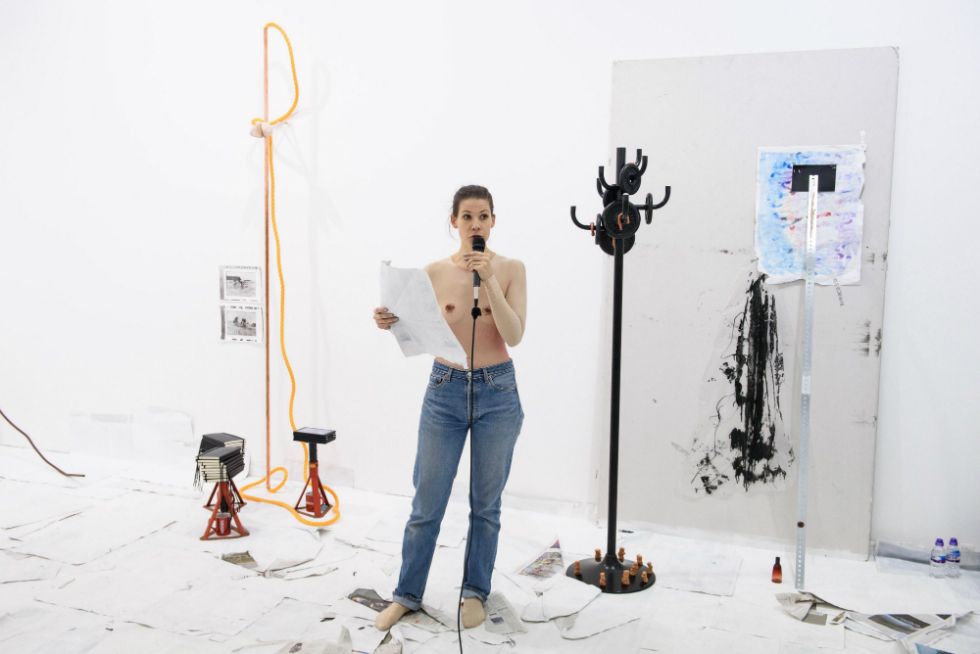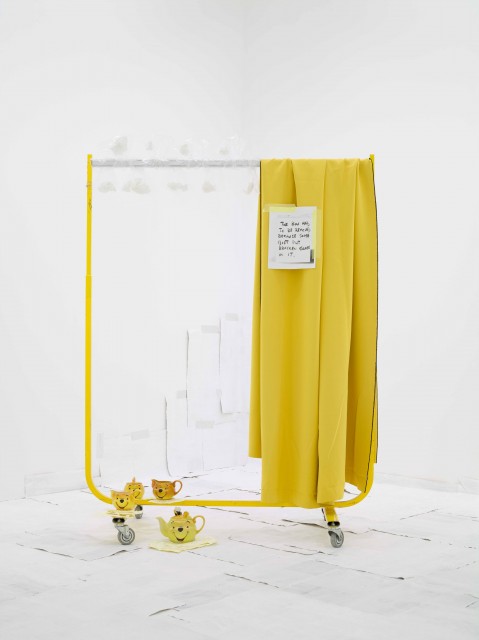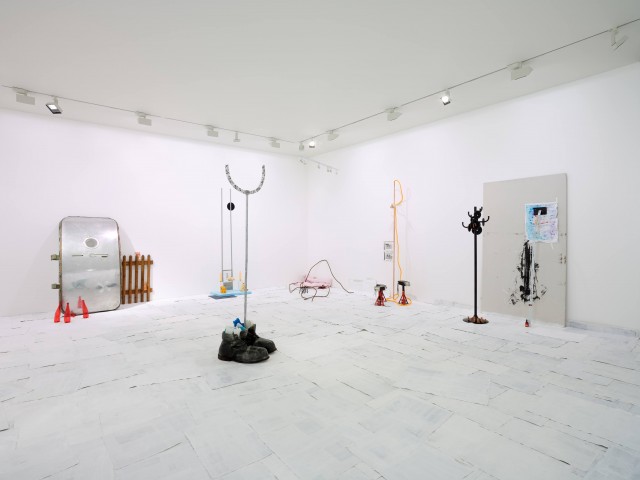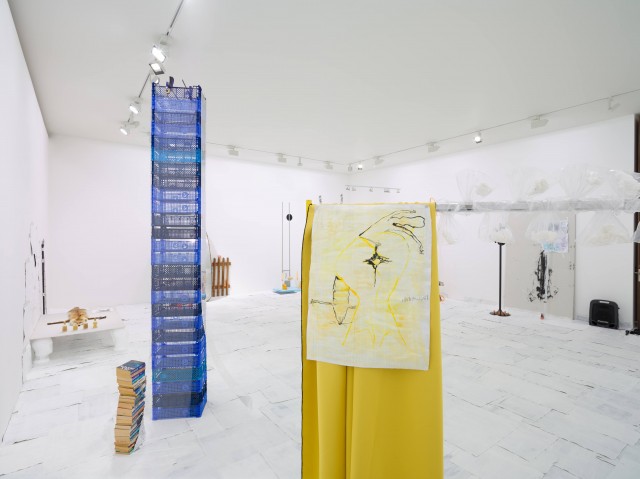“Women have to find a different kind of language…” The Big Interview: Sophie Jung

Wayne Burrows talks Freud, plurality and being “anti-conclusion” with artist Sophie Jung…
Sophie Jung was born in Luxembourg, grew up in Switzerland, and currently lives and works in London. She studied at Rietveld Academy, Amsterdam, and Goldsmiths, London. Recent solo exhibitions and performances include Come Fresh Hell or Fresh High Water (Blain/Southern Gallery, London), Producing My Credentials (Kunstraum, London), Ode on a Grecian Holiday (Ruine München, Saarbrücken) and Double (with Shana Moulton, Medienwerkstatt Wien, Vienna). She recently completed an Object Performance residency at Primary, Nottingham, and the resulting exhibition, Thusly, remains open until Saturday 24 February 2018.
The Double Negative: When I first saw Come Fresh Hell or Fresh High Water at Blain/Southern, going round the installation with your filmed performance on an iPad, it was interesting to try and decode which objects the texts were relating to at any particular time. At the live performance those relationships between texts and objects seemed much clearer, but with the iPad version it felt a bit like a Rorschach test, with the exact relationships left very open-ended.
Sophie Jung: It’s funny that you mention Rorschach in relation to Come Fresh Hell or Fresh High Water because that is exactly how I thought about it and put it together. It’s based on the same principle as the ink-blot test. It’s not about right or wrong interpretations, or about mapping a definite meaning onto any one thing. Instead, it’s set up to be conductive towards certain readings but leave room for an infinite number of variations.
The exhibition handouts suggested you were referencing Helene Cixous and her idea of women’s history being “written in white ink”, with the white newspapers, but there were lots of other things you didn’t explain.
That’s true, but everything is accounted for in the end, even when I don’t know quite why I’m using it. Every element in every sculpture will enter my script at various times and in various guises, be it their name that gets a foot in the door, their colour, their number, their metaphorical use, a rhyme to their designator, etc. So, with the white newspapers the space felt like an underground cave, which might be flood-prone, and I wanted to do something with it that was like the Freud couch in the Freud museum, where the couch is covered by a carpet and sits on a carpet against a carpet backdrop, which really confuses the space visually. I wanted to do something that could be installed in that way.
The Helene Cixous reference to “writing in white ink” came from my having to justify the use of those newspapers to my curator, which meant I had to think more deeply about why I wanted to install it that way. Helene Cixous was an inspiration anyway, and was in my mind, so it really arrived with her by that route.
It seemed appropriate because there’s something in Cixous and her ideas about language that relates to the way you use language in your own work.
Yes, because she has the idea that under patriarchy women have to find a different kind of language to represent their experience, a language which is non-hierarchical, that isn’t phallocentric. Under patriarchy, she says, women have to try and write in a male language, one that reflects the way that in the male body everything revolves around the phallus, which is like the one king, whereas the female body is more like a network, an egalatarian network of connections, so women, and those who identify as female, have to write ourselves in ways that counterweigh this language which isn’t really ours. And there’s also the idea of pleasure or lust in that, similar to Audre Lorde’s ideas around the power of the erotic, where we can use that one realm of language where women are allowed – or not allowed, that’s wrong, but anyway – where we can use the realm of the erotic to permeate everything, and say that, well, this fantasy and enjoyment of things might pervade anything that we do, if we and our language weren’t so restricted.

That resistance to hierarchy seemed important. There’s no sense of any single part of the exhibition being more or less important than any other. To the point that it’s hard to know exactly what the work is – it’s different when you’re performing live in the space to seeing it with the iPad, and another work again if you don’t use the iPad and just look at it as sculpture, or read the texts in a publication outside the installation.
They are all different incarnations and reincarnations of it and I think it’s important that there’s no centre, that it isn’t fixed as one thing or another because, in general, while I do read things in a specific way myself, I don’t believe in the idea of some predetermined reading that the artist is a key to. My role is to set up relationships. I might read things in a specific way – or several specific ways, based on the connotations I bring in and my history with the things I use – but the work can still be read in many different ways by other people who might bring very different connotations and histories into the space. And of course a lot of the relationships I set up are formal and have nothing to do with my specific history. I like the abundance. There is no conclusion; I am anti-conclusion.
The same thing applies to the texts and performances too, where there are lots of registers, lots of different kinds of formal and informal, spoken and written language, and beyond the actual words all the tones of voice, intonations, and body language – playing between different layers and kinds of language.
I just like to resist the idea in language that a word is assigned to a thing in a very fixed way, that the relationship between the word and the thing is how it has always been and will always be. Partly because a lot of prejudiced thinking is based on that, since that laziness is always built on a sense that, well: “I’ve built this box in my head and now I don’t want to mess with it”. So the more you allow plurality into your relationship with the world the better.
But there’s a fine line between confusing people completely, so they reject that plurality, which is not what I want to do, and relaxing people into it, drawing you into being comfortable with the idea that there are different voices, different realities, that there are multiple ways of reading the world and the work, so your own way of reading things can fit into it.
There’s an element of free association and word-play, too, which feels like a kind of signature in your work. I’d guess from your mentioning Freud and Cixous that there might be some psychoanalytic ideas in there somewhere?
I only started reading Freud quite recently, as I dismissed him for a long time, but recently I’ve been reading The Psychopathology of Everyday Life – the one that deals with slips of the tongue – and it’s amazing, all about language and the formal similarities that cause slips between words that suggest you really want to go somewhere with your story even though you don’t realise it, at least not consciously. When I write a text for a specific piece I’ll have a long list of associations, so with the yellow curtains it might have been a reference to the The Yellow Wallpaper by Charlotte Perkins Gilman, which is a reference maybe only a few people would pick up, which I don’t think I actually included in the end. The curtains are dressing room curtains, they are hospital curtains, they are final curtains. But then there is the note that’s pinned to those curtains – “The bin had to be removed because some idiot put brocken glass in it” – which is a very accessible reference that anyone can see immediately. In German, that misspelled “brocken” means a piece of something but is also the hill where witches gather and covens are supposed to have met.
I thought of the Brocken Spectre, when a shadow is seen on mist when you’re walking in mountains, so I guess that’s in a similar ball-park of meaning?
Exactly, and I wonder if that’s a coincidence, or if that word might be derived from German? I don’t know. The fact that English is such a mixture of different languages might be one reason why it’s such a good language to write in. But anyway, I have these lists of associations, based on elements like the colours, the shapes, the auras of the objects, even, and once they are there, I have them. Finding them is a process that happens in one take, where I can’t be disturbed because I really need to open all the gates, and that part of the process is quite close to free association writing, automatic writing.

But always based on the specific triggers of the objects?
Yes, based on those triggers. And, of course, once that first phase is done there is a very long process of editing, of putting new things in, of cutting things out, of making more links and connections, cutting right across the text, riddles and mazes in all directions. But that is much more conscious. The unconscious part of the writing comes at that first automatic, free associative stage, when I can bring out much more of myself than if I were working in a more bounded way to say a specific thing.
How did your art practice develop?
I was a photographer at first, and people in my family were in theatre, so in a way I chose photography to be safely away from the acting world. Then I did a three-month residency in an institution where people could come and look around while artists were at work, which was at the same time I was also studying at Goldsmith’s, so there would be long periods when I couldn’t be there. I started making assemblages of stuff to show during my absences, and because I was staying with my granny at the time a lot of the objects I used came from her attic. Then, because I also hadn’t studied art – I was still basically a photographer – the question nagged at me: ‘What does this mean? What is it?’ And the answer was: ‘I don’t know. It’s just some things I’ve assembled together’. That feeling of being a complete fraud led me to try and retrospectively give a meaning to what I was doing using text – except I am so allergic to meaning in the sense of conclusive understanding that my texts kept running away from it.
There’s a sense in your texts that they can work almost like skewed moral tales, often with political points, about work or housing for example.
There is a festival where I grew up in Switzerland, in Basel, called Fasnacht, it is a carnival that now has some kind of world cultural heritage status. It is an amazing spectacle that people in Basel are actively invested in, because it means rehearsing twice a week and committing to rehearsals all year round. It involves three days of drumming, piping and jesters and the whole of Basel has cellars where people rehearse. And for three days each year these cellars are all open to the public, and you go down, wait for the Schnitzelbängg jesters to come in costume. Then it’s one, two, three, four, and they all have an instrument, or their partner has an instrument, and they have a booklet of images on sticks like a parchment chart. They rhyme, and turn the pages, and tell stories, all with a political point, and you have to listen carefully to get these, as they can be quite subtle. Some stories are very entertaining, some are really bitter, some are left, some are right. As an audience you have to gauge it carefully, to make sure you don’t laugh at the wrong ones. In retrospect, I think this all had a huge influence. When I was growing up I always wanted to be one of those rhyming jesters, but because I wasn’t Swiss it wasn’t possible. I do often wonder if the work I’m making now is my own version of those Schnitzelbängg performances.
The way you play with English also seems very drawn to its quirks and eccentricities in a way I can’t imagine someone who grew up fully immersed in it would necessarily see.
I’ve got that advantage in picking up different types of delivery. As a kid I used to collect, I mean obviously I still collect things, but the idea of order is a mystery to me. So reshuffling things, finding new categories and new headers under which to arrange them, that is something I constantly do with objects and words. But then I reject all those categories. It’s always about how roles and languages are performed in context, because as contexts change the people change.
I also sometimes think I’m like a parrot. I find myself picking things up and repeating them without really knowing quite what I’m saying, just because the words are so strange. The more you repeat them the stranger they become until you’ve emptied them completely of all supposedly intrinsic content. And so you can start filling them again, responsibly. Also I’d say that so much is spoken in idiom and turns of phrases, I don’t think anyone ever really knows exactly what they’re saying, or rather most of what they use to come to a point is muddle.
Because you can think you’ve said one thing, then realise the person you spoke to has taken a different meaning from it to the one you intended?
Yes, exactly that, so in networking things there’s a kind of safety net built-in because there is so much content that if you get it wrong – or rather, because there is no getting it wrong, if nothing happens – at one place in the text, it can always happen somewhere else instead. I put in lots of points I want to hit but they’re not dependent on everyone getting the same meaning from each line. Whereas if you present a single linear text, whose core meaning depends on everyone getting one central metaphor in the same way, and they don’t all read it that way, then that’s it. It hasn’t worked.

Your approach raises the question of how far it applies only to individual pieces of work, with different pieces possibly connecting to become parts of a single, larger body of work? I’m guessing from what you’ve said that you wouldn’t see individual works as wholly self-contained and complete.
They are never complete – but there is one version of them once they have a text. Before they have a text they are definitely incomplete and are still seeping out in all directions, but once they have a text I feel like each has an identity sketched out. Then again, that larger work also does exist simply because I make and show these things, and if they don’t sell the individual items used to make them often end up back in my cellar and then get reshuffled to reappear in other pieces later. So, a curtain used in one piece might reappear playing a different role in another, and it’s the same with the words. There are certain idioms I use, certain word-plays, which lend themselves to being hinges. There are also certain topics I obviously keep coming back to. So perhaps that grander work is there in some way because all these works come from one collection, whether that is my collection of objects, or my vocabulary and my own particular ways of shuffling language.
It’s a natural way for artworks to be, yet there’s all too often an expectation that individual artworks should be discrete things, complete in themselves.
I did try to be more of a conceptual artist like that when I was doing photography, because with photography you could either depict things, or you could claim there was some kind of bigger concept behind it. Whether that was true or not, it’s the way it worked where I studied. You had to define the concept before you had the image, and I found it hard to understand that, because I don’t know how anyone could sustain it.
I realised that I’m actually interested in the exact opposite – not in concepts but in the patterns and connections between things. You can ignore those and try to be completely original and have a clear concept every time, or you can explore those patterns and connections and just see what they might do on their own. I think I can be a lot less controlling and more open to possibilities by working in that way. There is also the joy of making sense then making nonsense. Things can make no sense then make sense, and then that sense might collapse into something else again. It’s a process that has a lot of pleasure in it.
Wayne Burrows
See Sophie Jung: Thusly at Primary, Nottingham, until Saturday 24 February 2018 – FREE
Images: Come Fresh Hell or Fresh Hell Water Installation View 2017. Courtesy the artist and BlainSouthern. Photo Peter Mallet





